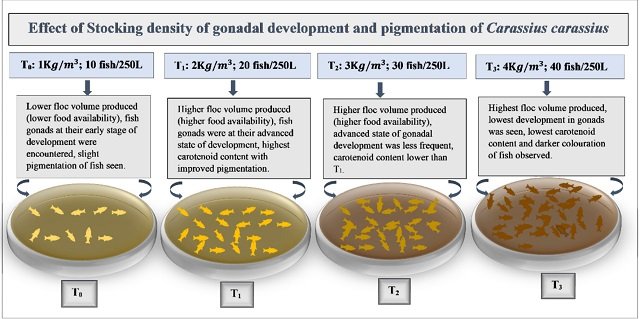
The Crucian carp (Carassius carassius) is a valuable aquaculture species known for its resilience, adaptability, and potential for ornamental purposes. However, optimizing production requires careful consideration of factors such as stocking density, which can significantly influence growth, reproductive performance, and overall health.
A study led by researchers from the Sher-e-Kashmir University of Agricultural Sciences and Technology of Kashmir (India) evaluated the effects of varying stocking densities on the gonadal development, pigmentation, and survival of Crucian carp (Carassius carassius) cultured in a biofloc-based system.
Benefits of BFT for Fish Reproduction
Studies have shown the positive effects of BFT on the reproductive performance of various aquatic species, including shellfish. BFT can improve reproductive success, larval survival, and the overall reproductive health of broodstock. Additionally, bioflocs are rich in carotenoids, which can enhance fish pigmentation and overall appearance.
Previous studies have highlighted the potential of biofloc technology for the sustainable aquaculture of carps.
Potential Benefits of BFT for Crucian Carp
The Crucian carp (Carassius carassius) is a valuable aquaculture species with potential for ornamental and food production. BFT may offer several benefits for cultivating Crucian carp, including:
- Enhanced Growth and Survival: BFT can provide a stable, nutrient-rich environment for Crucian carp, promoting growth and survival.
- Improved Reproductive Performance: Bioflocs can enhance the reproductive development and spawning success of Crucian carp.
- Improved Pigmentation: BFT can improve the pigmentation of Crucian carp, making them more attractive for ornamental purposes.
The Study
The researchers randomly distributed juvenile Crucian carp into sixteen tanks, each containing 250 liters of water. They evaluated four stocking densities: 1 kg/m³ (10 fish), 2 kg/m³ (20 fish), 3 kg/m³ (30 fish), and 4 kg/m³ (40 fish). The carbon-to-nitrogen ratio was maintained at 15:1 using wheat flour as the carbon source. Gonadal development, pigmentation, and fish survival were monitored.
Results
The main findings of the study were:
- Gonadal Development: The highest gonadal performance, including absolute and relative fecundity, gonadosomatic index (GSI), and advanced stages of maturation, was observed at a stocking density of 2 kg/m³ (20 fish/250 L).
- Pigmentation: Carotenoid content in the skin increased at lower stocking densities. Fish stocked at 2 kg/m³ exhibited the highest carotenoid content, resulting in a golden hue in their scales. In contrast, higher stocking densities led to greater melanophore dispersion, resulting in darker coloration, which may indicate stress.
- Survival: Survival rates did not significantly differ across the various stocking densities.
Implications for Crucian Carp Aquaculture
The findings of this study suggest that a stocking density of 2 kg/m³ is optimal for Carassius carassius cultured in a biofloc system. At this density, the fish demonstrated superior gonadal development, higher carotenoid content, and high survival rates.
Stay Always Informed
Join our communities to instantly receive the most important news, reports, and analysis from the aquaculture industry.
Moreover, the positive effects of lower stocking densities on pigmentation can be attributed to reduced stress and better access to resources.
Conclusion
“The results demonstrated that stocking density plays a very important role in gonadal growth, pigmentation, and fish survival in a biofloc system,” the researchers concluded.
This study provides valuable insights into the optimal stocking density for cultivating Carassius carassius in a biofloc system. By carefully considering stocking density, fish farmers can enhance reproductive performance, improve pigmentation, and ensure high survival rates. Future research may explore the long-term implications of stocking density on the health, welfare, and productivity of the fish.
Contacto
Uzma Nazir
Division of Aquaculture, Faculty of Fisheries, Sher-e- Kashmir University of Agricultural Sciences and Technology of Kashmir
190006, India
Email: uzmanazir9999@gmail.com
Referencia
Nazir, U., Rather, M. A., Chesti, A., Majeed, S., Zameer, F., Farooq, S., Aijaz, A., Ahmad, B., & Qadiri, S. S. N. (2024). Effect of stocking density on gonadal development, pigmentation and survival of Carassius carassius (Crucian carp) in a biofloc system. Aquaculture, 741477. https://doi.org/10.1016/j.aquaculture.2024.741477
Editor at the digital magazine AquaHoy. He holds a degree in Aquaculture Biology from the National University of Santa (UNS) and a Master’s degree in Science and Innovation Management from the Polytechnic University of Valencia, with postgraduate diplomas in Business Innovation and Innovation Management. He possesses extensive experience in the aquaculture and fisheries sector, having led the Fisheries Innovation Unit of the National Program for Innovation in Fisheries and Aquaculture (PNIPA). He has served as a senior consultant in technology watch, an innovation project formulator and advisor, and a lecturer at UNS. He is a member of the Peruvian College of Biologists and was recognized by the World Aquaculture Society (WAS) in 2016 for his contribution to aquaculture.




